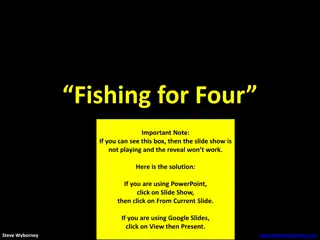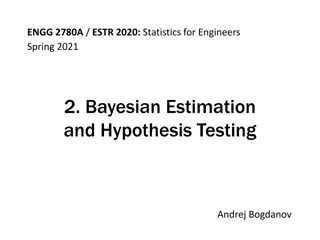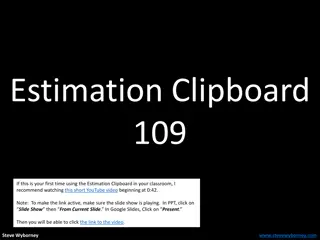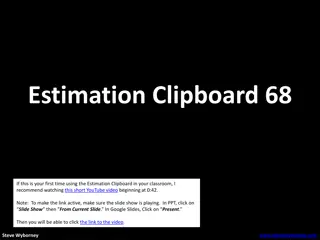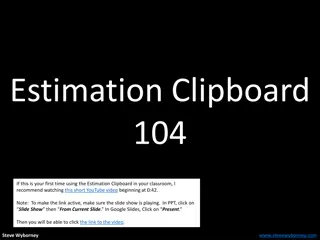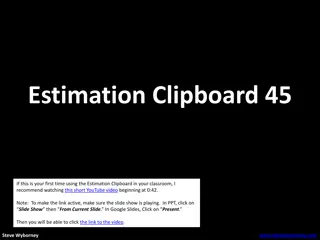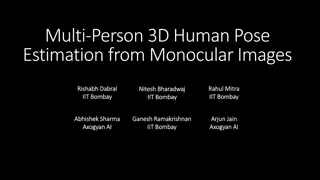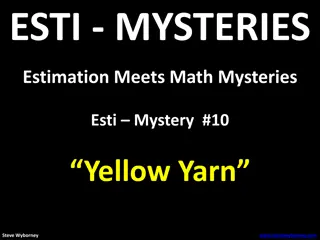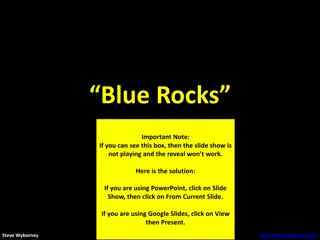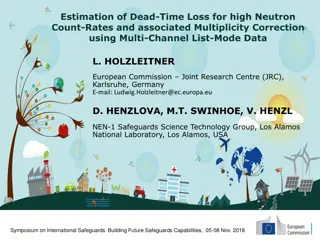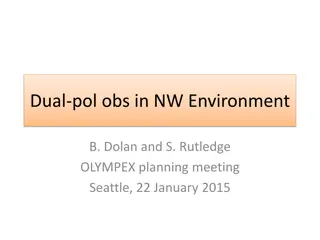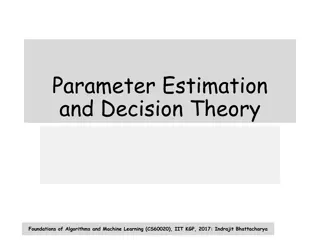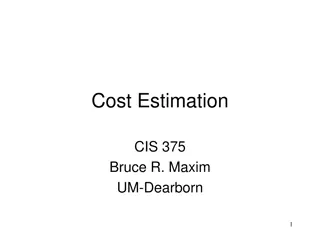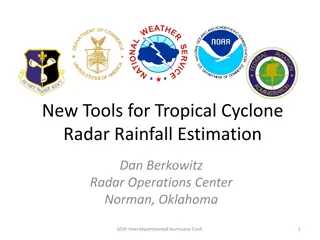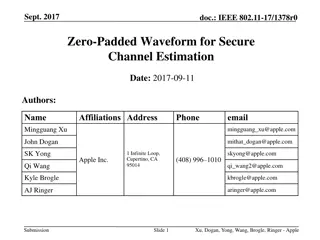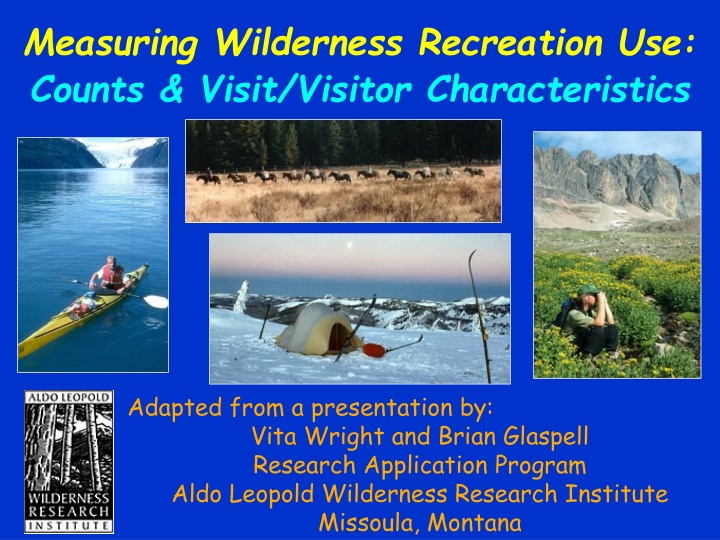
Wilderness Recreation Use Estimation Methods
Explore the challenges and importance of accurately estimating wilderness recreation use, as well as the implications for management decisions and resource allocation. Discover insights from surveys and research on monitoring social conditions in wilderness areas.
Uploaded on | 0 Views
Download Presentation

Please find below an Image/Link to download the presentation.
The content on the website is provided AS IS for your information and personal use only. It may not be sold, licensed, or shared on other websites without obtaining consent from the author. If you encounter any issues during the download, it is possible that the publisher has removed the file from their server.
You are allowed to download the files provided on this website for personal or commercial use, subject to the condition that they are used lawfully. All files are the property of their respective owners.
The content on the website is provided AS IS for your information and personal use only. It may not be sold, licensed, or shared on other websites without obtaining consent from the author.
E N D
Presentation Transcript
Measuring Wilderness Recreation Use: Counts & Visit/Visitor Characteristics Adapted from a presentation by: Vita Wright and Brian Glaspell Research Application Program Aldo Leopold Wilderness Research Institute Missoula, Montana
http://leopold.wilderness.net Social & Ecological Research Research Application
Todays Objectives Status of wilderness use estimation Handbook of methods & systems Components of a use estimation system Common types of use estimation systems
Reported Use Trends: How Accurate Are They? 200,000 Estimated # visitors1 Increase 175,000 482% 121% 150,000 125,000 100,000 403% 619% 184% 75,000 50,000 25,000 0 Year 1Based on USFS Recreation Visitor-Days as reported
Wilderness Use Estimation USFS Survey1 Results: Most managers indicated: Limited resources available (funding, personnel, equipment, training) Few systematic efforts to estimate use Little confidence in existing data Wide variation in experience with methods 1USFS Regions 4, 5, 8
Wilderness Use Estimation All Agencies Managers from 423 of 440 wildernesses were surveyed 63% relied on best guesses to estimate visitor use -- McClaran and Cole. 1993.
Why Monitor Social Conditions (visitor use) In Wilderness? Meet legal mandates (Wilderness Act, RPA1, etc.) and agency policy direction Increase confidence: Demand projections and use trends Input to decisionsabout limiting, managing, or distributing visitor use Credibility and support: Budget requests or management decisions 1Forest and Rangeland Renewable Resources Planning Act (1974)
Why Monitor Social Conditions (visitor use) In Wilderness? Management plans and actions LAC/VERP and baseline data needs Where/when to allocate field personnel Determining facility needs Agency reporting What else?
Commonly Identified Needs How to estimate use with multiple access points and/or highly dispersed use? How to estimate and correlate registration rates, permit compliance, etc.? How to assess previously collected data? How to do statistical sampling and calculations? How to get the best data for the least effort/cost? What are other places/agencies doing?
Wilderness Recreation Use Estimation: A Handbook of Methods and Systems http://leopold.wilderness.net/htopics/recuse.htm
What Is a Wilderness Use Estimation System? System = Technique 1. Objectives 2. Use characteristics of interest 3. Appropriate measurement techniques 4. Appropriate sampling strategy 5. Data analysis and summary
Handbook Organization Components of a use estimation system Objectives & use characteristics Use estimation techniques Sampling strategies for data collection Step-by-step implementation of 10 major use estimation systems
Recreation Use Measurements Counts Visitor-hours Recreation visitor days Sociodemographics Visitor knowledge Visitor attitudes and preferences Method of travel Group size Activity Length of stay Distribution Etc.
Step 1: Clarify Objectives Why are you collecting visitor use information? What question(s) are you trying to answer, and where? How are you planning to use this information? Who is interested in this information?
Examples of Objectives Why? Obtain baseline information Track trends Link recreation use with changes in ecological conditions Allocate/prioritize resources Analyze effects or need for closures & other administrative decisions
More Objectives Why? Identify commercial vs. noncommercial use Improve communication with visitors Identify different visitor groups Set social standards (planning frameworks) Prove/disprove assumptions
Example Objectives Statement Where Managers at XXXX Wilderness want to know if the amount of use and sociodemographics have changed since baseline data was collected in 1985. (day and/or overnight use) What
Example Objectives Statement Where Managers at XXXX Wilderness want to know if the amount of use and sociodemographics have changed since baseline data was collected in 1985. Information will be gathered to estimate the amount, type, and distribution of use. Desired sociodemographics data includes age, sex, income, residence, and # of previous visits. What What What
Example Objectives Statement Where Managers at XXXX Wilderness want to know if the amount of use and sociodemographics have changed since the permit system was discontinued in 1985. Information will be gathered to estimate the amount, type, and distribution of use. Desired sociodemographics data includes age, sex, income, residence, and # of previous visits. This information is needed for revision of the management plan. What What What Why
Example Objectives Statement Where Managers at XXXX Wilderness want to know if the amount of use and sociodemographics have changed since the permit system was discontinued in 1985. Information will be gathered to estimate the amount, type, and distribution of use. Desired sociodemographics data include age, sex, income, residence, and # of previous visits. This information is needed for revision of the management plan. Data collection will be considered part of existing personnel duties. It is anticipated that personnel can contribute 1-2 days/week to data collection. Minimal funds are available for additional equipment. What What What Why How
Step 2: What Use Characteristics Do You Want To Measure to Meet Your Objectives?
Step 2: What Use Characteristics Do You Want To Measure? (p. 9) Visit counts: Number of times past a site Visit attributes: Characteristics of visits Visitor attributes: Characteristics of visitors Summary use statistics: Combine visit attributes with visit counts
Visit Counts Individual visits Group visits Visitor Attributes Sociodemographics Past experience Knowledge Attitudes & preferences Visit Attributes Method of travel Group size Length of stay Activity Commercial services Temporal distribution Spatial distribution Wilderness conditions Summary-Use Statistics (Counts + visit attributes) Visitor-days (24 hrs) Recreation visitor-days (12) Overnight stays
Use Characteristics Do they meet objectives? Visit counts. Site-specific plans for high use sites; ignores visit attributes Method of travel, group size, spatial & temporal distribution. Location & nature of impacts; field personnel allocation Commercial use. Necessity of commercial allocations; impacts; trends; conflicts Sociodemographics. Visitor contact methods Past experience & knowledge. Resource protection & education strategies Attitudes & preferences. Anticipate response to management strategies Counts Visits Visits Visitors Visitors Visitors
Example Objectives Statement Managers want to know if the amount of use and sociodemographics have changed since baseline data was collected in 1985. Sociodemographics include: age, sex, income, residence, and # of previous visits. Information will be gathered to estimate: amount, type, and distribution of use. Visitors Counts Visits
Step 3: Which Measurement Techniques Meet Your Needs?
Visual Observation Mechanical Counters Registration External, internal, roaming Categories of Use Estimation Techniques Indirect Estimation Permits Surveys
Structure of Systems Use characteristics that can be measured Measurement techniques Equipment purchase Equipment installation Data collection strategies Visitor use calculation
Choosing a Counter Sample from Handbook (p. 23) Installation site Equipment vandalism Environmental influences on accuracy Cost Maintenance requirements Method of calibration
Types of Counters Type Approx. Cost Accuracy Vandal Resistance Active Infrared Passive Infrared Seismic $200-$1200 Good-Very Average Good Poor $130-$400 Good $75-$350 Poor- Average Not evaluated Very Good Not evaluated Inductive Loop $300
System B: Steps (p. 79) Counters with observer calibration 1. Use characteristics measured 2. Counter type 3. Number of counters needed 4. Calibration method 5. Sampling plan 6. Purchase equipment 7. Install equipment 8. Collect calibration data 9. Collect counter data 10.Estimate use
System G: Steps (p. 128) Permits with compliance checks and interviews 1. Use characteristics 2. Permit form 3. Permit-issue procedure 4. Sampling plan 5. Purchase/install equipment 6. Select/train interviewers 7. Collect compliance rate and interview data 8. Estimate use
Summary of Techniques The most appropriate technique provides: Data that meet objectives Minimal visitor burden Acceptable cost Desired accuracy
What determines if a sampling technique is good? All methods are good and can produce high quality results All methods can be bad without good application To assure good results be sure to have a good : - sampling strategy/plan - implementation of sampling plan
What Is a Wilderness Use Estimation System? System = Technique 1) Objectives 2) Use characteristics 3) Measurement techniques 4) Sampling strategy 5) Data analysis and summary
Step 4: Design a Sampling Plan (i.e. Strategy for Data Collection)
Why Sample and not Census Efficiency Sampling = studying a part to gain information about the whole Less time and cost than a census of the entire population Obtain a sample that is representative of the population
Why Statistics? So we can sample rather than census the population. Helps us design projects that meet our accuracy goals. Helps us understand what we can and can t say about our population, from our data.
Confidence in Numbers (Based on Random Sampling) Discuss results in probability terms: I am 95% confident that between June 1 and September 30, there were between 5,250 and 5,340 visits to the XXX Wilderness. Right 19 of 20 times
Eliminating Bias Bias = some units represented more in sample than population 1) Convenience/judgment sampling based on assumptions/guesses may not represent the population 2) Random sampling protect against bias represent the population
Steps Before Sampling 1) Define the population 2) Define the sampling unit 3) Determine appropriate sample size
Population All members of the group that you want to learn about Bounds: Entire Wilderness Local population Summer dates Group: All visitors Day users Packstock users Sampling unit = subset
Sample Size: How many days to sample? How many people to sample?
How many days to sample? How many people to sample? Based on: Variability in measured characteristic; obtained from a previously collected data or preliminary survey How precise do you want your sample estimate to be? Cost: available personnel & budget Precision vs. cost
Step 5: Entering and Analyzing Data What tools do you have? Software: Excel, Access, SPSS, SPLUS, others? Stats Analysts Can Help!
The Analysis Paralysis What to do with all the data ? Count and weigh the boxes Use locally generated database/spreadsheet programs Use corporate information management programs (i. e. FS Infra-WILD VUPS)
Analysis Paralysis solutions? Analysis of data is just as important as collection of data Plan ahead Include in cost estimates Seek help through agency IM staff and other wilderness managers Utilize off-season volunteers, SCA, front office staff, university grad. student ???
What Is a Wilderness Use Estimation System? System = Technique 1) Objectives 2) Use characteristics of interest 3) Appropriate measurement techniques 4) Appropriate sampling strategy 5) Data analysis and summary
Types of Use Estimation Systems Convenience or judgment sampling External Visual Observations Internal Visual Observations stationary and roaming Mechanical Traffic Counters Registration Permits limited and non-limited Visitor Surveys Indirect estimation Aerial surveys
Types of Use Estimation Systems Convenience or Judgment Sampling (Best Guesses) Inherent bias due to biased sample selection and untested assumptions Common examples: - visitors that are convenient or easily surveyed - vocal supporters or critics - visitors at easily accessible trailheads

